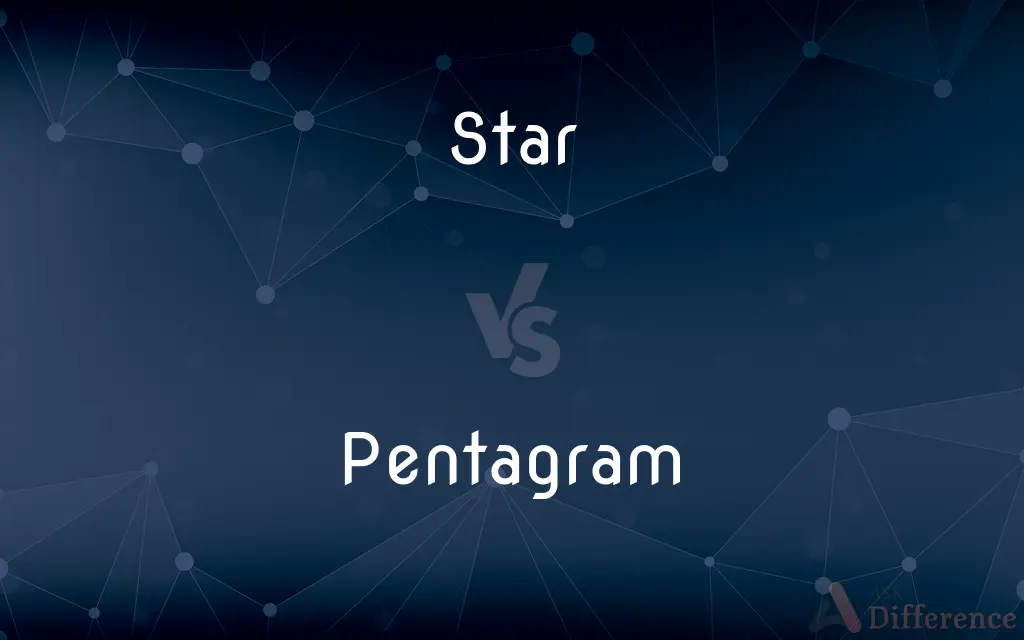Star vs. Pentagram — What's the Difference?
Edited by Tayyaba Rehman — By Fiza Rafique — Updated on March 14, 2024
A star is a celestial body emitting light and heat, while a pentagram is a five-pointed star symbol, often with magical or religious significance.

Difference Between Star and Pentagram
Table of Contents
ADVERTISEMENT
Key Differences
A star, in astronomical terms, is a massive, luminous sphere of plasma held together by gravity, located in space and visible from Earth as a light point in the night sky. The pentagram, on the other hand, is a geometric figure consisting of five straight lines forming a five-pointed star, commonly used in various symbolic contexts, including religion, magic, and heraldry.
Stars have been studied in the field of astronomy, where their composition, life cycle, and impact on the universe are analyzed. They are fundamental to galaxies and have been essential in navigation and calendar systems. Pentagrams are used in symbolic practices; for example, in paganism and Wicca, it represents the five elements—spirit, water, air, fire, and earth—and is used for protection and magical rites.
While stars are natural celestial bodies observed in the universe, pentagrams are human-made symbols with assigned meanings varying across different cultures and religions. The use of the pentagram dates back to ancient civilizations, where it held different significances, including as a symbol of health in Greek tradition.
The observation of stars has led to significant discoveries in the field of physics, such as nuclear fusion, and has implications for understanding the universe's origin. The pentagram, by contrast, plays a role in cultural and religious practices, influencing art, literature, and rituals.
The appearance of stars in the night sky has inspired countless myths, legends, and scientific inquiries, making them a subject of fascination across all cultures. Pentagrams, with their precise geometric shape and symbolic depth, continue to be a powerful symbol in modern esoteric traditions and popular culture.
ADVERTISEMENT
Comparison Chart
Nature
Celestial body emitting light and heat.
Geometric figure with symbolic significance.
Use/Significance
Studied in astronomy, navigation, and calendar systems.
Used in religion, magic, and heraldry.
Composition
Plasma, held together by gravity.
A figure drawn with five straight lines.
Cultural Impact
Inspirational in myths, legends, and science.
Holds magical, religious, and cultural meanings.
Historical Context
Observable throughout human history.
Dates back to ancient civilizations.
Compare with Definitions
Star
A massive, luminous sphere of plasma in space.
The Sun is the closest star to Earth, providing light and warmth.
Pentagram
Used historically as a symbol of health and protection.
Ancient Greeks associated the pentagram with the goddess Hygeia.
Star
Studied for understanding the universe's composition.
Astronomers study distant stars to learn about galaxy formation.
Pentagram
Appears in modern culture and esoteric traditions.
The pentagram is often seen in fantasy literature and movies as a symbol of magic.
Star
Observed in constellations across the night sky.
Sailors historically navigated using stars like Polaris.
Pentagram
Found in Christian symbolism to represent the five wounds of Christ.
Medieval Christians used the pentagram as a symbol of Christ's wounds.
Star
Source of light and inspiration in various cultures.
Stars have been depicted in countless pieces of art and literature.
Pentagram
Represents the five elements in pagan religions.
Each point of the pentagram corresponds to spirit, water, air, fire, and earth.
Star
Central to our solar system, supporting life on Earth.
Without the star we call the Sun, life on Earth would not exist.
Pentagram
A five-pointed star symbol with magical and religious significance.
The pentagram is a common symbol in Wiccan traditions.
Star
A star is an astronomical object consisting of a luminous spheroid of plasma held together by its own gravity. The nearest star to Earth is the Sun.
Pentagram
A pentagram (sometimes known as a pentalpha, pentangle, pentacle or star pentagon) is the shape of a five-pointed star polygon. Pentagrams were used symbolically in ancient Greece and Babylonia, and are used today as a symbol of faith by many Wiccans, akin to the use of the cross by Christians.
Star
A celestial body that generates light and other radiant energy and consists of a mass of gas held together by its own gravity in which the energy generated by nuclear reactions in the interior is balanced by the outflow of energy to the surface, and the inward-directed gravitational forces are balanced by the outward-directed gas and radiation pressures.
Pentagram
See pentacle.
Star
Any of the celestial bodies visible at night from Earth as relatively stationary, usually twinkling points of light.
Pentagram
The shape of a five-pointed star constructed of five intersecting lines meeting at the vertices, such that a central pentagon and five surrounding isosceles triangles are formed; often with magical connotations; a 5/2 (or 5/3) star polygon.
Star
Something regarded as resembling such a celestial body.
Pentagram
A pentacle or a pentalpha.
Star
A graphic design having five or more radiating points, often used as a symbol of rank or merit.
Pentagram
A star with 5 points; formed by 5 straight lines between the vertices of a pentagon and enclosing another pentagon
Star
An artistic performer or athlete whose leading role or superior performance is acknowledged.
Star
One who is highly celebrated in a field or profession.
Star
An asterisk (*).
Star
The star key on a telephone
For customer service, press star.
Star
A white spot on the forehead of a horse.
Star
A planet or constellation of the zodiac believed in astrology to influence personal destiny.
Star
Stars The future; destiny. Often used with the.
Star
Outstanding or famous, especially in performing something
A star researcher.
A star figure skater.
Star
Of or relating to a star or stars.
Star
To ornament with stars.
Star
To award or mark with a star for excellence.
Star
To mark with an asterisk.
Star
To present or feature (a performer) in a leading role.
Star
To play the leading role in a theatrical or film production.
Star
To do an outstanding job; perform excellently.
Star
Any small luminous dot appearing in the cloudless portion of the night sky, especially with a fixed location relative to other such dots.
Star
(star) A luminous celestial body, made up of plasma (particularly hydrogen and helium) and having a spherical shape. Depending on context the sun may or may not be included.
Star
(geometry) A concave polygon with regular, pointy protrusions and indentations, usually with four, five, or six points.
Star
(acting) An actor in a leading role.
Many Hollywood stars attended the launch party.
Star
An exceptionally talented or famous person, often in a specific field; a celebrity.
His teacher tells us he is a star pupil.
Star
(printing) An asterisk (*) or symbol (★).
Star
A symbol used to rate hotels, films, etc. with a higher number of stars denoting better quality.
Star
A simple dance, or part of a dance, where a group of four dancers each put their right or left hand in the middle and turn around in a circle. You call them right-hand stars or left-hand stars, depending on the hand which is in the middle.
Star
(astrology) A planet supposed to influence one's destiny.
What's in the stars for you today? Find out in our horoscope.
Star
A star-shaped ornament worn on the breast to indicate rank or honour.
Star
A composition of combustible matter used in the heading of rockets, in mines, etc., which, exploding in the air, presents a starlike appearance.
Star
(intransitive) To appear as a featured performer or headliner, especially in an entertainment program.
She starred in dozens of silent movies.
Star
(transitive) To feature (a performer or a headliner), especially in a movie or an entertainment program.
The show stars Calista Flockhart as a high-powered lawyer.
Star
(transitive) To mark with a star or asterisk.
Star
(transitive) To set or adorn with stars, or bright, radiating bodies; to bespangle.
Star
(intransitive) To shine like a star.
Star
One of the innumerable luminous bodies seen in the heavens; any heavenly body other than the sun, moon, comets, and nebulæ.
His eyen twinkled in his head aright,As do the stars in the frosty night.
Star
The polestar; the north star.
Star
A planet supposed to influence one's destiny; (usually pl.) a configuration of the planets, supposed to influence fortune.
O malignant and ill-brooding stars.
Blesses his stars, and thinks it luxury.
Star
That which resembles the figure of a star, as an ornament worn on the breast to indicate rank or honor.
On whom . . . Lavish Honor showered all her stars.
Star
Specifically, a radiated mark in writing or printing; an asterisk [thus, *]; - used as a reference to a note, or to fill a blank where something is omitted, etc.
Star
A composition of combustible matter used in the heading of rockets, in mines, etc., which, exploding in the air, presents a starlike appearance.
Star
A person of brilliant and attractive qualities, especially on public occasions, as a distinguished orator, a leading theatrical performer, etc.
Star
To set or adorn with stars, or bright, radiating bodies; to bespangle; as, a robe starred with gems.
Star
To be bright, or attract attention, as a star; to shine like a star; to be brilliant or prominent; to play a part as a theatrical star.
Star
(astronomy) a celestial body of hot gases that radiates energy derived from thermonuclear reactions in the interior
Star
Someone who is dazzlingly skilled in any field
Star
Any celestial body visible (as a point of light) from the Earth at night
Star
A plane figure with 5 or more points; often used as an emblem
Star
An actor who plays a principal role
Star
A performer who receives prominent billing
Star
A star-shaped character * used in printing
Star
The topology of a network whose components are connected to a hub
Star
Feature as the star;
The movie stars Dustin Hoffman as an autistic man
Star
Be the star in a performance
Star
Mark with an asterisk;
Linguists star unacceptable sentences
Star
Indicating the most important performer or role;
The leading man
Prima ballerina
Prima donna
A star figure skater
The starring role
A stellar role
A stellar performance
Common Curiosities
How are stars important to science?
Stars are crucial for understanding the universe's composition, physics laws, and the life cycle of celestial bodies.
What is the main difference between a star and a pentagram?
A star is a natural celestial body, while a pentagram is a symbolic geometric figure.
Do stars have any symbolic meanings like pentagrams?
While stars themselves are celestial bodies, they've been imbued with symbolic meanings in various cultures, representing hope, guidance, and destiny.
Why is the pentagram associated with magic and the occult?
Its use in ancient and medieval symbolism and its representation of the elements and spirit made it a powerful symbol in magical rites and esoteric traditions.
How do astronomers classify stars?
Astronomers classify stars based on their spectral type, luminosity, size, and composition.
Is the pentagram always associated with negative forces?
No, the pentagram's association varies widely across cultures and is often seen as a protective symbol in pagan and Wiccan beliefs.
Why might someone wear a pentagram symbol?
People might wear it for protection, to express religious or spiritual beliefs, or as an affinity for the symbolism associated with it.
Can a pentagram represent a star?
Yes, a pentagram can symbolically represent a star, especially in contexts relating to magic and religion.
Can the shape of a star in the sky look like a pentagram?
The points of light we see as stars can form various shapes in constellations, but they don't naturally form perfect pentagrams without human interpretation.
How are pentagrams depicted in art and literature?
Pentagrams are often depicted as symbols of magic, mystery, and esoteric knowledge in various forms of art and storytelling.
What are some common uses of the pentagram in modern times?
It's used in religious and pagan ceremonies, as well as by individuals seeking protection or practicing modern witchcraft.
How does the study of stars impact our understanding of the universe?
It helps scientists understand cosmic processes, such as nuclear fusion, and provides insights into the universe's age, structure, and future.
What is the role of stars in the life cycle of the universe?
Stars play a critical role in the cosmic cycle, from the synthesis of elements to the formation of new stars and planets from supernova remnants.
What is the significance of stars in navigation?
Stars have been used for centuries in navigation to determine direction and position at sea or in the desert at night.
Are there cultural practices that utilize both stars and pentagrams?
Yes, many cultures and spiritual practices draw on both the astronomical significance of stars and the symbolic power of pentagrams.
Share Your Discovery

Previous Comparison
Dory vs. Skiff
Next Comparison
Deputation vs. SecondmentAuthor Spotlight
Written by
Fiza RafiqueFiza Rafique is a skilled content writer at AskDifference.com, where she meticulously refines and enhances written pieces. Drawing from her vast editorial expertise, Fiza ensures clarity, accuracy, and precision in every article. Passionate about language, she continually seeks to elevate the quality of content for readers worldwide.
Edited by
Tayyaba RehmanTayyaba Rehman is a distinguished writer, currently serving as a primary contributor to askdifference.com. As a researcher in semantics and etymology, Tayyaba's passion for the complexity of languages and their distinctions has found a perfect home on the platform. Tayyaba delves into the intricacies of language, distinguishing between commonly confused words and phrases, thereby providing clarity for readers worldwide.















































